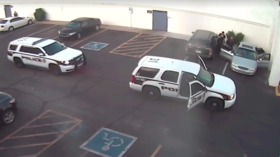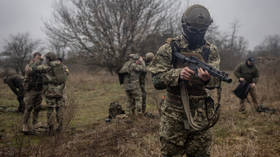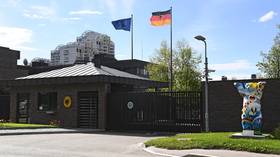US police shoot 1,000 people dead every year - report
A new investigation has revealed that no matter the circumstances, American cops shoot almost 1,000 people dead every year.
The line between life and death can be crossed in a split second, as was the case with 20-year-old Willie McCoy on Saturday night. Police came upon the amateur rapper sleeping in his car with a handgun on his lap outside a Taco Bell in Vallejo, California. Officers drew their weapons when McCoy stirred and woke up, and ordered him to “keep his hands visible.”
When McCoy allegedly moved his hands towards his weapon, the officers opened fire. McCoy died on the scene.
Saturday’s shooting was just one of the almost 1,000 fatal police-involved shootings that take place in the United States every year, according to data compiled by the Washington Post. As everything else changes, that number remains the same. 998 people were shot and killed by cops last year, up from 987 in 2017. 963 people were shot and killed by police in 2016, and 995 in 2015.
45 percent of these victims were white males, while 23 percent were black males. 96 percent of the victims were armed, half of these with guns, and 25 percent were in “mental distress” at the time of their shooting. Only five percent were women.
Other investigations give similar figures. Mapping Police Violence, a site that tracks shootings from a black activism perspective, found that officers killed 1,166 people in 2018.
Some of these incidents made national headlines. The shooting of Michael Brown – an unarmed black man – by police in Ferguson, Missouri, in 2014 ignited a national debate on police brutality and race relations, and spawned the Black Lives Matter movement. The death of Jemel Robertson – a Chicago security guard who was shot dead by police while himself stopping a shooting – last year illustrated that four years on, America still struggles with the twin problems of race relations and gun violence.
Police officers interact with the public around 50 million times per year, with these interactions leading to fatal shootings only 0.00002 percent of the time. An interaction can end in deadly violence for any number of reasons. A crazed attacker opens fire on the public before police put him down; a domestic abuser charges officers with a knife; officers mistake a replica gun for a real one and shoot a teenager.
A variety of factors have been put forward to explain the consistently high rate of fatal police shootings. Widespread gun ownership seems to be one, as states like Alaska, Georgia, Idaho, Kentucky and Louisiana with more gun owners had 3.6 times more incidents than low-ownership states like Connecticut and Massachusetts.
Also on rt.com Chicago police receive lessons in ethics… from officers accused of abuse – reportPolice policy seems to be a factor too. Washington DC is among the US’s most dangerous cities, and police seized more than 2,000 illegal guns there in 2017. Despite this high-risk environment, DC police shot and killed only two people that year. Two decades earlier, officers were retrained after shooting 15 people per year.
New York also implemented some restrictions on the NYPD’s use of force in the 1970s, which dropped the rate of fatal shootings from 93 in 1971 to 41 two years later. Despite a citywide crackdown on crime in the 1990s, officer-involved shootings remained low. In 2015, only eight suspects – one in a million New Yorkers – were shot and killed by police.
Still, the number of people killed every year remains near constant. “We’ve looked at this data in so many ways, including whether race, geography, violent crime, gun ownership or police training can explain it, but none of those factors alone can explain how consistent this number appears to be,” criminologist Geoffrey Alpert told the Washington Post.
Mathematics offers a more likely explanation. With so many police-civilian interactions every year, there is a small probability that an interaction might end up with the civilian dead. As long as the probability remains mostly constant, so too will the number of deaths. While every shooting is the result of a complex line of decisions by all involved, the overall rate is more predictable.
“Just as vast numbers of randomly moving molecules, when put together, produce completely predictable behavior in a gas, so do vast numbers of human possibilities, each totally unpredictable in itself, when aggregated, produce an amazing predictability,” mathematician Sir David Spiegelhalter told the Post.
Think your friends would be interested? Share this story!















